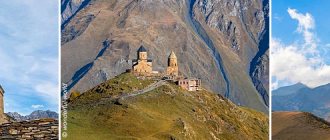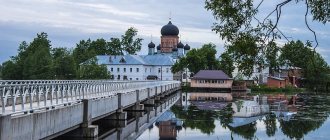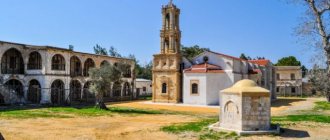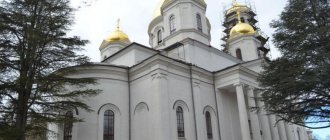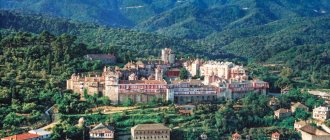I would like to emphasize right away that the title of the article should not be taken literally. Firstly, I not only do not undertake to talk about all the monasteries, but I also don’t know how many there are. Secondly, it is wrong to talk about the Russian North in a geographical or administrative-territorial sense. It is rather a historical and cultural concept, the signs of which have been formed over many years in the territory of different regions of Russia. Thirdly, acquaintance with the monasteries (in place and time) was determined not by my wishes, but by the route of the Moscow-St. Petersburg-Valaam-Moscow river cruise. At planned stops, cruise organizers offer tourists various excursion options, including to monasteries. That's what we'll talk about.
But first of all, a few words about the Kalyazin bell tower. Another deviation from the stated topic. This is not the north yet, but a place on the way from Moscow, a port of five seas, including along our route. Not a single cruise ship leaving the Northern Port of the capital can pass the former bell tower (1800) of the former St. Nicholas Cathedral (1694) of the former St. Nicholas Zhabensky Monastery. Therefore, the most important thing about her. The height above the water level is 70 meters. In the old days, the bell tower had 12 bells, the largest of which (weighing 1038 pounds) was cast in 1895 with funds from the cathedral in honor of the accession to the throne of Nicholas II.
Kalyazinskaya bell tower
In the 30s of the last century, after the construction of the Uglich hydroelectric station and the formation of the reservoir, a significant part of Kalyazin, including undismantled monastery and cathedral buildings, found itself in the flood zone. The bell tower was left as a beacon. There are different versions of how that decision was made, as well as several legends and true stories, one way or another connected with the bell tower and its large bell. But this is a separate topic.
Solovetsky Monastery
Everyone has seen the Spaso-Preobrazhensky Solovetsky stauropegic monastery of the Russian Orthodox Church. There is no exaggeration in this statement - the monastery is depicted on the 500-ruble banknote. Without this simultaneously tragic and beautiful place, it is impossible to imagine the history of Russia. Today the monastery is a famous center of pilgrimage. Even those lucky ones who have been to Solovki several times and, it seems, have traveled the length and breadth of the island, coming again, are sure that discoveries await them again.
Photo by Vladimir Eshtokin
The monastery is the first attraction that everyone who arrives on Bolshoy Solovetsky Island gets acquainted with. An architectural ensemble with a 500-year history. A defensive fortress that protected the North of Russia for centuries. Here you need to examine not only the Transfiguration Cathedral and the Church of the Annunciation, the battle towers of the fortress and the one-pillar Refectory Chamber - you can examine every stone, every cage, every, even the most seemingly inconspicuous building. There is a story behind everything. And there are also monasteries, a Botanical Garden, a lighthouse temple on Sekirnaya Mountain, canals, many museums and the amazing nature of the Solovetsky Islands.
We present to you ten interesting places that a tourist should see on Solovki:
Look
Find out ten most important moments from the history of the great monastery:
To know
and ten more interesting facts about the Solovetsky Islands:
Which ones have you not heard of yet?
Alexander-Oshevensky Monastery[edit]
Alexander-Oshevensky Monastery is an Orthodox monastery in the village of Pogost (Oshevenskoye) in the Kargopol district of the Arkhangelsk region.
Address
: Arkhangelsk region, Kargopol district, village. Oshevenskoye, Pogost village.
The city of Kargopol can be reached by train or bus.
Bus No. 520 runs from Arkhangelsk to Kargopol, departure once a day, at 7.00 (travel time 12 hours).
The nearest railway station is Nyandoma (Nyandoma). The distance from Kargopol to Nyandoma by road is 80 km.
There is a bus from Nyandoma to Kargopol (No. 976), scheduled several times a day (travel time 1.5 hours).
Then take bus number 304 from Kargopol to Oshevensk (40 km).
Kirillo-Belozersky Monastery
The Cold Cave on the shore of Lake Siverskoye, in Belozerye, became a voluntary shelter for the former rector of the Moscow Simon Monastery, Hieromonk Kirill. According to legend, this remote northern desert was shown to him by the Most Holy Theotokos herself in 1397. Over time, students came to him and the large Assumption Belozersky Monastery grew here, later called Kirillo-Belozersky.
Photo by Oleg Uzorov
This monastery not only played a significant role in the history of Russian monasticism, but also found itself at the center of significant events in Russian history. The “golden age of Russian holiness” is associated with it, when in the 15th century the “spiritual stream from Trinity-Sergius” rushed here. Among the disciples of St. Cyril were Nil of Sorsky, Korniliy of Komelsky, Ignatius of Lamsky, Alexander Oshevensky. Each of them subsequently founded their own monastery, where the charter of Kirill Belozersky was observed.
During the Time of Troubles, the Kirillov Monastery became the only monastery in the Russian North that the interventionists could not ruin. The monastery was favored by kings. All his life, Ivan Vasilyevich the Terrible passionately loved the Kirillov Monastery and generously donated to it. At the same time, unwanted and disgraced nobles were often exiled here.
In 1997, part of the territory of the monastery was transferred to the Vologda diocese. In the same year, the Divine Liturgy was served in the church over the tomb of St. Kirill Belozersky for the first time in many years. Currently, the revived Kirillo-Belozersky monastery continues to be restored.
Read how the great northern monastery grew from the cave of a lonely monk:
History of the monastery
Nilova Hermitage on the Sora River (turn at approximately 20 km of the Kirillov - Belozersk road)
The personality of the Monk Nile is extremely curious - after many years of travel in the East, he founded a monastery with a monastery charter that was new in our country at that time, borrowed from Mount Athos. According to the behest of St. Nile, monks were to feed on the labor of their hands, accept alms only in extreme need, and avoid the love of things and luxury even in church; women were not allowed into the monastery, monks were not allowed to leave the monastery under any pretext, and ownership of estates was denied.
Today, the impressive structure is used in the same way as in Soviet times: it houses the “Home for the Invalids of the Pustyn”. No restoration or conservation work has been carried out on the desert and, unfortunately, is not expected in the near future...
Trinity-Gledensky Monastery
The Trinity-Gleden Monastery was founded a very long time ago, at the end of the 12th century, almost at the same time as the city of Gleden, the predecessor of Ustyug. It became one of the first centers of Christianity in the pagan lands of Podvinia, and its unique 18th-century iconostasis is one of the main attractions of Veliky Ustyug.
This city monastery with an ancient history was considered one of the richest on the Dvina land. In 1659, in the Trinity-Gledensky Monastery, one of the most perfect stone Trinity Cathedrals in the Russian North was built on a hill. It was consecrated no earlier than 1705–1710. At first the cathedral was single-domed, now it is crowned with five faceted domes. There are very beautiful multi-colored tiles on the facades.
Tourist groups go to the Trinity Cathedral, which today has been turned into a museum, primarily to see the extraordinary iconostasis.
Find out where this unusual “secular” iconostasis with mirrors came from in the 12th century Trinity-Gledensky Monastery in our material:
Where did the mirrors go?
Belozersk (120 km from Vologda)
According to legend, Rurik’s younger brother came to rule in Beloozero, one of the oldest Russian cities. Local braves took part in almost all important battles in Russian history, and the city itself developed as a major port.
It is curious that in 2000 Belozersk was invited to the Hanseatic League (the fourth of the Russian cities) - thanks to the prominent contribution of medieval Belozersk to the development of trade with the cities of Northern Europe. An excellent opportunity to talk about trade and the structure of cities in Medieval Europe.
Today's Belozersk is notable for its ancient ramparts, the Assumption Cathedral with a 16th-century iconostasis, located on the territory of the local Kremlin, and quiet streets where you can find wooden and stone structures that have not changed their original appearance at all.
We really remember the ferry on which we crossed Sheksna, the fishmonger in the local grocery store and the wonderful view from the ramparts of the city and White Lake.
Assumption Trifonov Monastery
The monastery was founded in 1580 by the Monk Tryphon of Vyatka. The saint came to Vyatka from the Chusovsky estates of the Stroganov salt industrialists. The monastery began with two wooden churches - the Annunciation and the Assumption. Soon two monastic settlements appeared next to the monastery. In subsequent centuries, the wooden monastery buildings were rebuilt in stone.
In 1918 the monastery was closed. The Assumption Cathedral continued to function as a parish church. The monks were repressed, the surviving premises housed communal apartments, dormitories, a garment factory, a bakery, a fuel oil boiler room... In the Assumption Cathedral, where the archive was located, fortunately, the pre-revolutionary iconostasis was preserved.
Restoration work at the monastery began in the 1950s and continued in the 1980s. In the late 80s - early 90s, the Holy Dormition Trifonov Monastery was reopened. The Assumption Cathedral became the cathedral church of the diocese. The temples and buildings of the monastery were restored, the Assumption Cathedral was re-painted, and in 2004, the largest bell in the diocese was cast using donations.
Find out more about this monastery and other shrines of the Vyatka land:
8 shrines of the Vyatka land
St. John the Theologian Convent[edit]
The Sura women's community was founded in the village of Sura in 1899 on the initiative and support of Archpriest John Ilyich Sergiev (John of Kronstadt). In 1900, the community was transformed into a run-of-the-mill convent. Initially, a wooden church in honor of John the Evangelist and monastic cells were built. Since 1907, the monastery had a courtyard in Arkhangelsk. In addition, the Ioannovsky Monastery in St. Petersburg was also first founded as a metochion of the Surskaya community.
The monastery and the Arkhangelsk metochion were closed in the 1920s. Until the end of 1941, nun Angelina (Trukhina) lived in the village of Sura. She was arrested for the fact that “secret religious services were being held” in her house, and on June 22, 1942, she was shot.
The only convent in the Arkhangelsk diocese at this time was founded on October 31, 1994, with the blessing of Bishop Panteleimon of Arkhangelsk and Murmansk.
Address
: Arkhangelsk region, Primorsky district, Ershovka village
Telephone
: (8182) 25-51-94
Spaso-Prilutsky Monastery
In 1371, in the bend of the Vologda River, the disciple of St. Sergius of Radonezh, Saint Demetrius of Prilutsky, founded the Spaso-Prilutsky Demetrius Monastery. This event had a profound impact on the development of the entire region for several centuries.
Photo: spas-priluki.ru
From the moment of its foundation, the Spaso-Prilutsky Monastery became the main outpost of the Moscow state in the North of Rus'. It is very conveniently and favorably located - at the intersection of both water and land routes. Princes and kings took care of him, seeing the Spaso-Prilutsk monastery as an important military-strategic and trade point in the North of Russia. But at the same time, the monastery has always remained the spiritual center of the Vologda region, associated with the names of great saints and with the veneration of shrines that are significant for all of Russia.
Like many other churches and monasteries, the 20th century became a tragic time for the Spaso-Prilutsk Monastery. The monastery was closed by the Soviet authorities back in the 1920s. Then there was a transit prison, warehouses, a cinema...
And in 1991, after a 67-year break, the monastery was reopened in Spaso-Prilutsky. And in 1992, the monastery was completely returned to the Russian Orthodox Church. Monastic life is being revived. Buildings are being repaired, iconostases and bells in the cathedral bell tower have been restored, and a full range of services are held daily.
Which famous poet is buried in the necropolis of the Prilutsk monastery? Why are the monastery towers so “cheerfully” painted? Read in our material:
Spaso-Prilutsky Monastery
Artemiev-Verkolsky Monastery[edit]
A men's monastery founded by the Kevrol governor A. Pashkov in 1635 at the temple in which the relics of the rights were kept. Artemy Verkolsky. Officially opened in 1649. For a long time it was not rich, in the 1st half. XIX century was in decline.
After the introduction of a communal charter in 1867, under the care of a number of abbots, it became one of the largest and most famous monasteries in the diocese with a large farm. Stone cell buildings and a fence with towers were built (1869-1879).
Closed at the beginning 1920s, the buildings were used as a commune, an orphanage, a school, a children's boarding school, some of the buildings are broken. Reopened in 1991.
Address:
Arkhangelsk region, Pinezhsky district, pos. New way
Ferapontov Monastery
Photo: vk.com/ferapontov.monastery
Ferapontov, or rather, the Ferapontov Belozersky Nativity Monastery is both an Orthodox shrine and an object of enormous cultural significance (included, by the way, on the UNESCO World Heritage List). It is located in the Vologda region, twenty kilometers from the city of Kirillov and one hundred and twenty kilometers from Vologda. This is one of the oldest monasteries in the Russian North, founded in 1398.
It was founded by the Monk Ferapont, a student and friend of the Monk Sergius of Radonezh. The frescoes in the Ferapontov Monastery were painted by the famous icon painter Dionysius. The deposed Patriarch Nikon languished in captivity in the monastery. Now the Ferapontov Monastery is both a monastery and a museum.
For you - six interesting facts about the Ferapontov Monastery:
Read
Housing and food
2 km from the center of Kirillov there is the tourist village "Ekotel" - a nice and well-equipped recreation center, which includes a very interesting children's playground, a large space for walking and a farm with rabbits, kids and poultry. The most affordable accommodation option is in one of the cabins of a real barge. The most thorough one is in a Scandinavian or Russian style house with a piece of its own sandy beach and all kinds of other amenities. You can rent bicycles and boats at Ecotel.
If you are ready to spend the night in a tent, an excellent place for this is Sokolsky Bor near the village of Topornya (10 km from the center of Kirillov) - a protected forest, carefully converted into a campsite along the shore of the Sheksna, which has widely overflowed here. For a nominal fee you will receive the right to spend the night, wooden toilets, prepared firewood and well-equipped parking lots surrounded by pine trees and sandy beaches.
There are essentially two options for accommodation in Ferapontovo: the recently renovated Russian Yard Hotel and the private sector - there are many advertisements for houses for rent. The hotel has an extremely good location, but it has a rather unsightly design and not very reasonable prices. You can choose a house with access to the lake, a bathhouse and a boat - to look at the monastery from the water and travel around the entire beautiful Borodaevsky Lake.
Outside of Vologda, you shouldn’t pin your hopes on affordable and at the same time high-quality public catering - in most places it’s easier to buy something in a store than to find a suitable cafe. Therefore, we recommend looking for accommodation with “home-cooked” food or the ability to cook yourself.
Pechenga Monastery
In the 16th century, in a wild country “near the cold sea, near the Murmansk border,” the newly minted monk Tryphon set up the first cells of the future Pechenga monastery at the Trinity Church. One day a large bear wandered into one of the huts and, knocking over the kneading bowl left there, began to eat the prepared dough with appetite. Tryphon, approaching the wild beast, first forbade it to move, and then let it go. Since then, not a single forest predator has ever disturbed the monks or attacked the monastery herd of deer.
Patriarch Kirill’s visit to the Pechenga Monastery in 2021
At the end of the 1550s, the pious Tryphon, who began to be called the “apostle of the Lapps,” reached Moscow and received a letter of grant from Tsar Ivan the Terrible, declaring the Holy Trinity Pechenga Monastery a new stronghold of the Russian state in the Far North. The king ordered to “extend the monastery’s possessions to abandoned whales and walruses, to sea shores, islands, rivers and small streams, upper reaches of rivers, toni (fishing grounds), mountains and pozhni (hayfields), forests, forest lakes, animal catches,” and all local residents with their lands were proclaimed subjects of the sovereign, assigned to the monastery.
Several times the monastery was ruined, moved and again revived and flourished... Nowadays, another revival of the northernmost monastery in Russia continues in its original place, where the Namajoki River flows into Pechenga - where it was founded by the Monk Tryphon.
Find out how the “apostle of the Lapps” tamed bears in the northernmost monastery in Rus':
And other stories about the monastery
Kozheozersky Epiphany Convent[edit]
The monastery was founded on the peninsula of Lake Kozhozero by the monks Nifont and Serapion. It burned several times with the loss of all the temples. In 1758, due to its small number, it was assigned to the Spaso-Preobrazhensky Monastery; in 1764 it was abolished with the conversion of the churches into parish ones. Restored in 1851 as attached to the Nikolo-Korelsky Monastery. In 1853 it gained independence for missionary purposes, and stone construction began. In 1918 it was closed and looted; a commune was located on the territory, later a settlement for exiles. The area was abandoned in the 1950s. A worship cross was installed in 1991, and monastic life has been resumed since 1998. In 2009 it was converted into a women's monastery.
Address:
Russia, Arkhangelsk region, Onega district, Kozheezersky (Kozhozersky) monastery
- From Moscow to Vologda, and from there at 14 o’clock by train “Vologda – Murmansk” to Nimenga station. Or by train "Moscow - Arkhangelsk" to Obozerskaya station, then by local trains to Nimenga station (the schedule changes frequently).
- From Nimenga station, take a passing timber truck 80 km to the forest path leading to the monastery. Typically, timber trucks start running at 6 a.m. (except Sundays and holidays).
- The path along the path to the monastery is 30 km. Sisters are not blessed to travel along the path to the monastery on their own!
Boris and Gleb Monastery
The place for it was chosen by the Monk Sergius of Radonezh himself. The monastery was a powerful fortress that protected Rus' from invasions from the West. The great monk Peresvet, who fell in the Battle of Kulikovo, labored here. From here the holy recluse Irinarch blessed the troops of Minin and Pozharsky for the liberation of Moscow from the Poles and Lithuanians. The great Russian princes and the first Russian tsars loved the Boris and Gleb Monastery and considered it their home.
Find out more about the Borisolevsky Monastery and its amazing history:
How did he become “home” for the kings?
Sursky St. John the Theological Convent[edit]
The monastery, created by Archpriest. John of Kronstadt in his native village, where he was born in 1829. Opened in 1899 as a women's community, already in 1900 it was converted into a monastery. During the 1900s, a brick fence with towers and a multi-tiered bell tower, a number of cell buildings were built, and a large farm was created. Closed in 1920, later some of the buildings were dismantled, some were occupied by a hospital. In the 2000s, the female monastic community was restored, but the monastery has not yet been officially opened. The sisters live in the former house of the monastery priest.
Notes
: In the 1900s, the house in which John of Kronstadt spent his childhood was transported to the monastery, placed under a wooden cover for safety.
Address
: 164630, Arkhangelsk region, Pinezhsky district, Sura village, st. them. I. Kronstadtsky, 16
Telephone
: +7(81856) 5-22-92; 5-21-12
